
Experimental microcosms placed inside a stream. Custom made frames hold them in place, whilst the sampling team extract samples and process in the area situated opposite.

Microcosms in situ. Each jar is fitted with a motorised lid fitted with a paddle to stir the water. Fiddly but very rewarding when in synchrony!

Water clarity at the site.
Great to have the first set of experiments complete for the @ercrefresh.bsky.social project! Eight days in a beautiful chalk stream studying the role of DOM in freshwater systems as part of a @ukri.org and @erc.europa.eu funded programme.
21.07.2025 07:04 — 👍 4 🔁 1 💬 0 📌 0

Male Beautiful Demoiselle damselfly, abundant at our clay stream site in SW England.

Female Beautiful Demoiselle damselfly at our site.

These damselflies frequently landed on us and our equipment as we worked.

We found several of these small, native freshwater limpets on our biofilm slides when we extracted them. Ancylus fluvialitis.
That's a wrap on our @erc.europa.eu @ukri.org @ercrefresh.bsky.social programme 2nd expt.. A very different environment than the chalk stream in our 1st expt. but nonetheless with wonderful biota: Beautiful Demoiselle damselflies fluttering around us, and freshwater limpets grazing our biofilms! 🧪
06.08.2025 08:38 — 👍 13 🔁 2 💬 0 📌 0
Fantastic field season with the team. Looking forward to sample and data analyses over the winter, then planning for our 2026 field campaign on the back of those findings!
27.08.2025 13:05 — 👍 1 🔁 0 💬 0 📌 0
Come and join us. We're already underway with major experiments throughout the summer. Huge opportunity for the right candidate! See link for details. 🧪
11.07.2025 14:39 — 👍 3 🔁 2 💬 0 📌 0
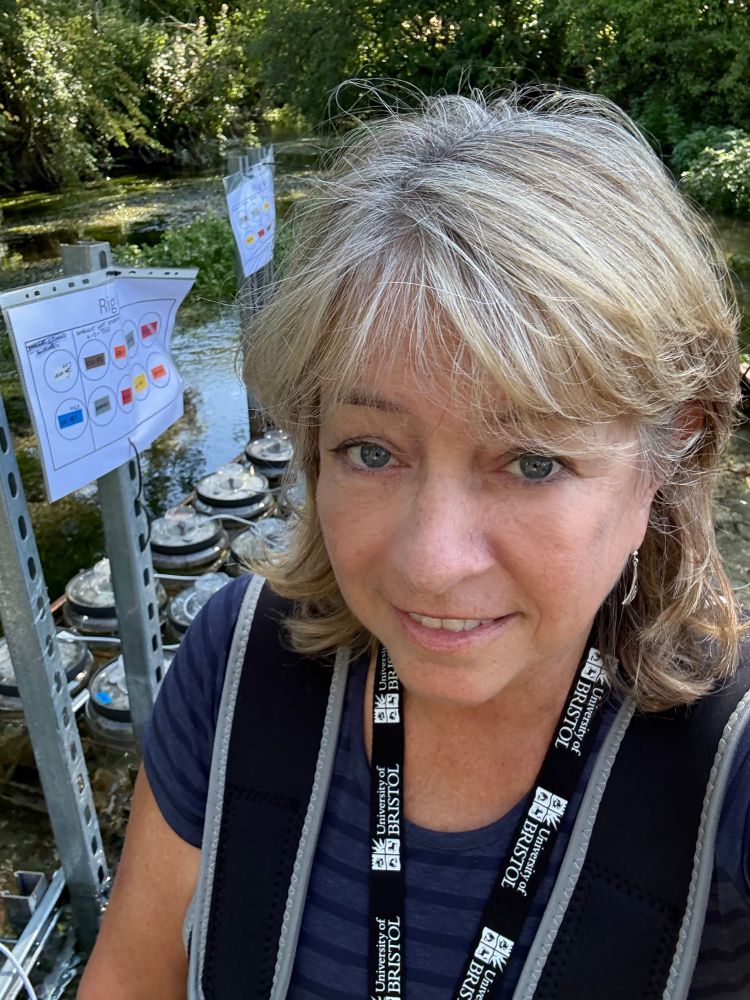
PI setting up for 48 h sampling at our chalk stream site.

Dr Charlotte Briddon transferring our biofilm frames to our clay stream site to start incubation. Each frame holds 45 glass slides, and we need c. 450 for each experiment.
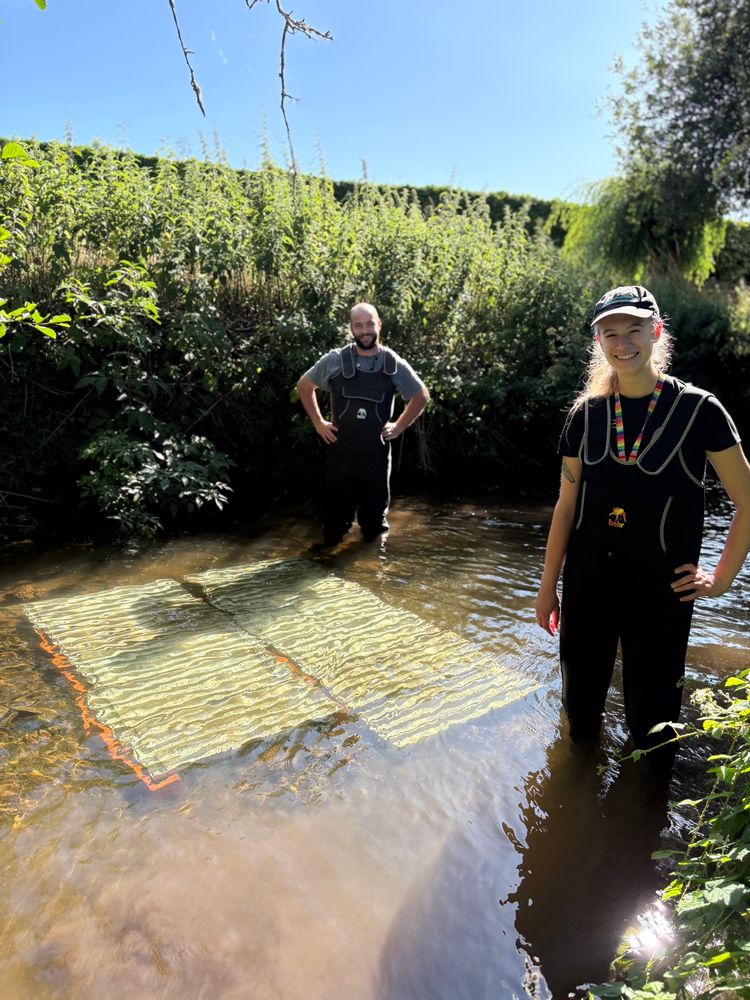
@jameslmcdonald.bsky.social from ERC REFRESH and @sydneyenns.bsky.social from NERC QUANTUM deploying the frames in a sunny part of the stream.
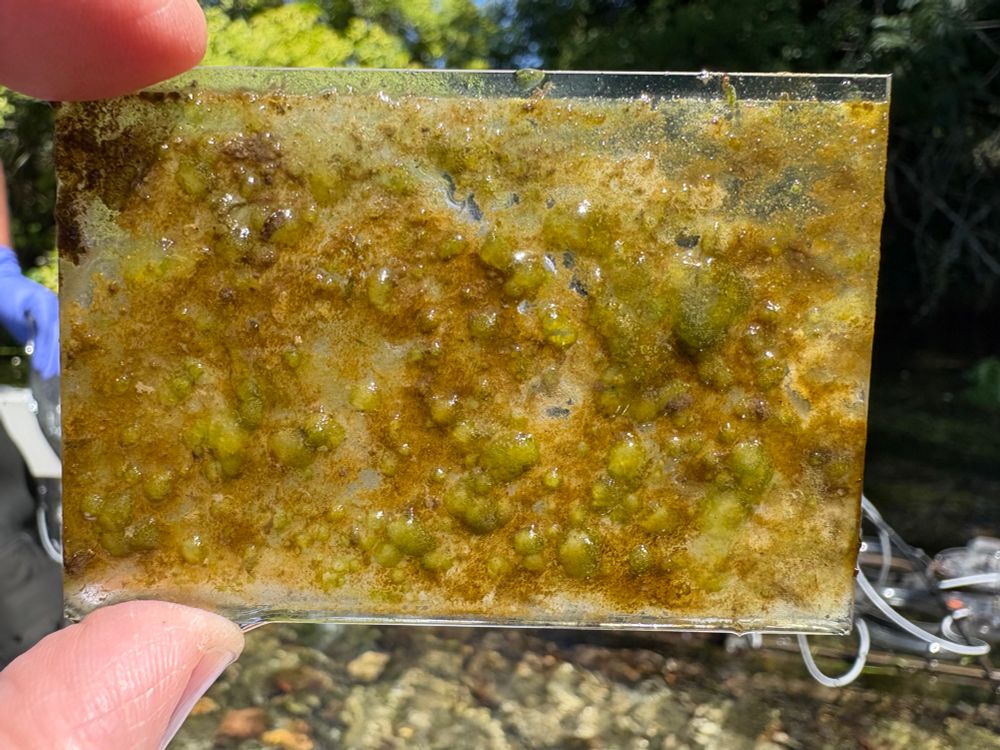
A biofilm coated slide at 48 h sampling time point.
Four time points out of 6 completed in our first experiment (chalk stream) and it's all going well. Next stop is deployment of the biofilm frames in our clay stream to develop biofilms for experiment 2 in 3 weeks time. Great help from @sydneyenns.bsky.social from our @ukri.org QUANTUM team. 🧪
11.07.2025 09:52 — 👍 5 🔁 1 💬 0 📌 1
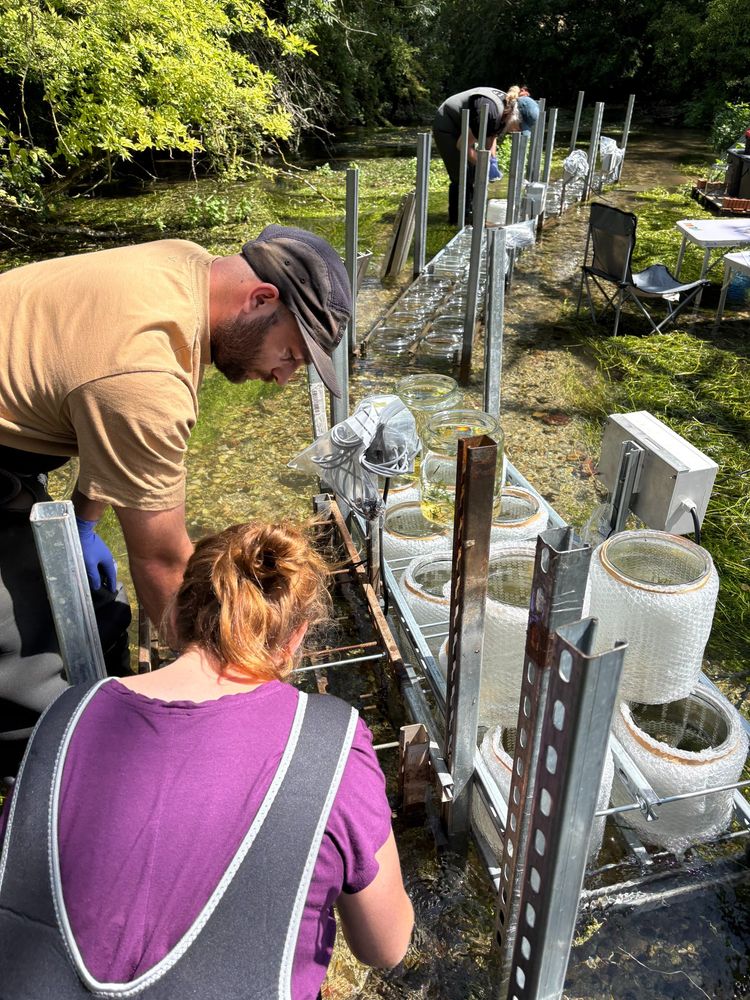
Meet the team! Drs Charlotte Briddon and @jameslmcdonald.bsky.social, working on setting up the motors to drive the paddles in our warming (bubble wrap jackets, elevated higher in the water column) and warming plus high (double the rpm) flow velocity experiment. Further along, Dr @acastrocastellon.bsky.social from our @ukri.org NERC QUANTUM programme is setting up the jars for our ambient temperature with stirring experiment in this classic chalk stream. The catchment comprises calcium carbonate rich chalk, flows to the river are dominated by groundwater and deeper throughflow, and the stream ecosystem supports Ranunculus spp. (water crowfoot), Callitriche spp. (starwort) and Rorippa nasturtium-aquaticum (watercress) along with a native brown trout population. How will biotic response rates to isotope dosing of 13C15N labelled compounds in this alkaline, and gin-clear stream contrast with those in a more turbid clay stream (experiment 2) and dystrophic peatland stream (experiment 3). We look forward to finding out!
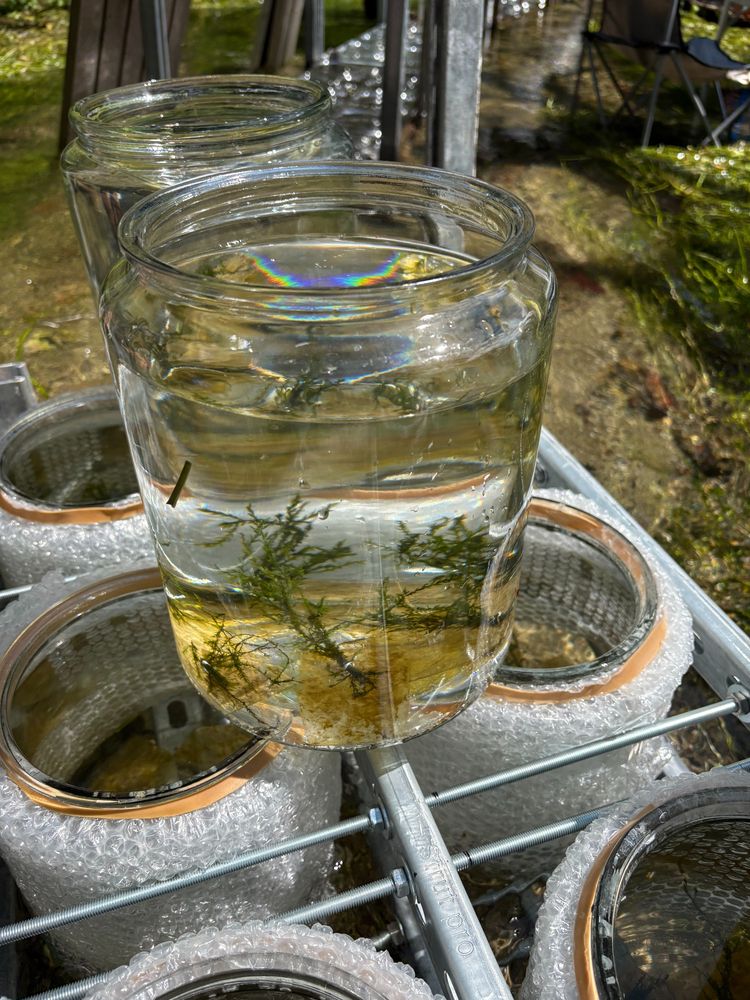
Each jar contains biofilms cultivated in the stream prior to each experiment, and mosses (Fontinalis antipyretica) which are ubiquitous in UK rivers and streams. Their lack of rooting structure makes them ideal for these isotope dosing experiments. Later on in the programme we will introduce benthic chambers and endemic higher plants, but these 6L mesocosms are too small to accommodate them.

The final set up, the evening before the first sampling at time point 0. We then sample at 1.5 h, 6 h, 24 h, 48 h, 96 h (at which point we introduce snails to graze off the biofilms and bryophytes) and 192 h. So many moving parts to go wrong, and each jar 9x 3 replicates) receives a different dual-labelled DOM compound at 1% enrichment of N over background. These are not enrichment nor depletion experiments (those come later in this 5 year ERC Advanced Grant programme, awarded to @penny.johnes.bsky.social ) and funded via @ukri.org under the Horizon Guarantee.
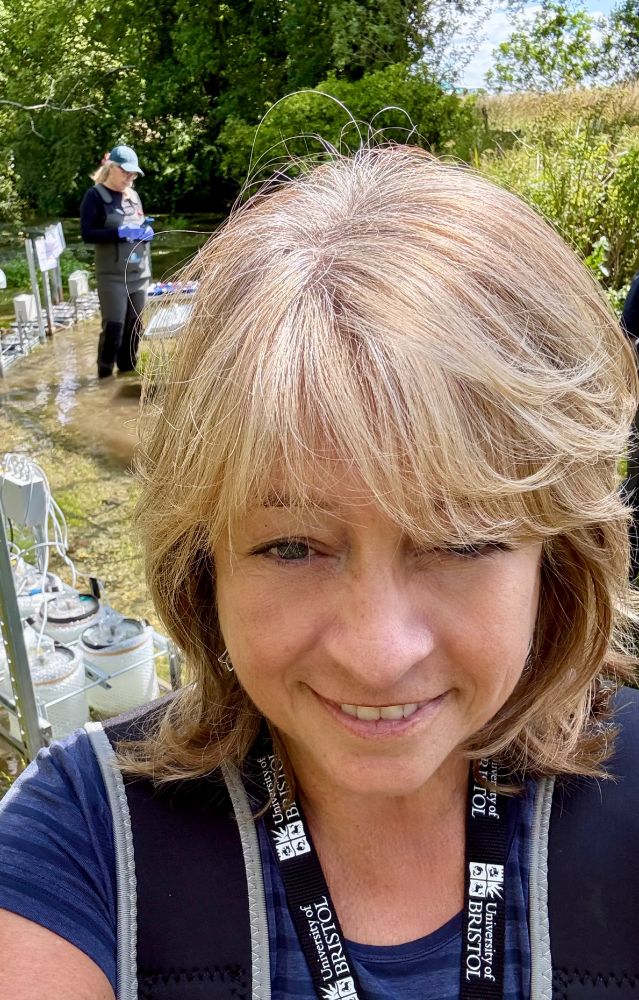
The PI @penny.johnes.bsky.social having rather too good a time. Science is always fun, but also often quite challenging when we are conducting experiments under environmental conditions. It's always a relief when the kit is in and working and the design is correct!
Follow the team @ercrefresh.bsky.social as we investigate controls on rates & pathways of DOM uptake into stream foodwebs. This week we ran the first of 3 experiments exploring if environmental character, warming or velocity affect uptake this week. Chalk stream first, then clay stream, then peat! 🧪
09.07.2025 15:23 — 👍 10 🔁 2 💬 0 📌 1
Researcher at University of Oxford | Environmental Chemistry
Interdisciplinary environmental research and education community at the University of Bristol. Food security, water, low carbon energy, city futures, environmental change, natural hazards & disaster risk, climate change & health. www.bristol.ac.uk/cabot
PhD Student, University of Oxford DTP in Environmental Research. Researches magmatic systems in volcanic arcs. Sulphur, sulphides, Lesser Antilles Arc, volcanoes, subduction zone geochemistry.
PhD in River Ecology (ULisboa)
Postdoctoral researcher at Senckenberg Research Institute
From Spain, based in Berlin
Specialised in Data Science and Landscape Ecology
Postdoc at the FEHM-lab. Researcher in community ecology, mostly in freshwater ecosystems. Member of the French Confederation of Early Career Researchers.
Angler and fisheries biologist, in that order | Fish 🐟 diets, trophic ecology, #fishpuke 🤮, population dynamics, fisheries management | @afs-scicomm.bsky.social prez | he/him | views are mine
📍 northeast Minnesota
🔗 linktr.ee/kamden.glade
Professor for #Freshwater and #Restoration #Ecology @hsmagdeburgstendal.bsky.social
rivers|fish|fisheries|ecosystem mgmt|models
DadX2
https://www.science.org/doi/10.1126/science.adf0895
https://scholar.google.de/citations?user=04y3iwsAAAAJ&hl=en
Associate Professor of Zoology / Prof. Titular, University of Oviedo, Spain.
Teaching Evolutionary Biology
Research in evolutionary ecology in extreme environments
#radioactivity #Chornobyl #amphibians #ZoologicalCollections
www.gorizaola.wordpress.com
Assistant Professor of Fish Biology at UNL | Deep-sea fish evolution | Join us at the #SundayFishSketch 🗓️🐠✍️ | lampichthys.com
Conservation research scientist @miistakis.bsky.social. Artist.
PhD in Ecology. Post-doctoral fellow at #IEA_UdG @greco-udg.bsky.social
#Bioinvasions #Species-HabitatRelations #AquaticEcology
Also, Mom. Bookworm. Foodie. Coffee addict. Home baker.
Freshwater ecologist , Postdoctoral researcher, University of the Basque Country
Integrative Zoology in Human-Modified Freshwaters 🌿🦟🐟🦠. Professor and Researcher at @BiologiaUB @IRBioUB @hubsg_ #FORESTREAM SGR group.
Lecture Professor at the University of Lleida.
Postdoc researcher in amphibian ecology and conservation.
Herbivore 🌱
Associate Professor of Ecology @ub.edu | Aquatic Ecology and Biogeochemistry | http://canbas.weebly.com
Freshwater ecologist, Research Fellow
@NTUSciTech (UK), into rivers and the critters living in them 💧🦞🦠🍂🏳️🌈
Biogeographer who is excited about freshwater plants and #geodiversity | father | cyclist | AC Oulu supporter. PI #Macrophyte #Biogeography Lab (macrophytes.weebly.com) and co-PI physical geographers (oyluma.weebly.com), University of Oulu. He/his.
Fish Scientist & Prof, aka “The Gar Guy” | 🌎Freshwater Conservation | SciComm • GarLab | Views mine | he/him | #GarWeek
Wherever you go, there you gar
https://linktr.ee/solomonrdavid • @garlab.bsky.social














